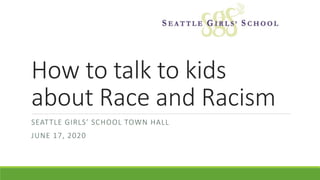
How to talk to kids about race and racism
- 1. How to talk to kids about Race and Racism SEATTLE GIRLS’ SCHOOL TOWN HALL JUNE 17, 2020
- 2. Young children notice and think about race. Adults often worry that talking about race will encourage racial bias in children, but the opposite is true. Silence about race reinforces racism by letting children draw their own conclusions based on what they see. Teachers and families can play a powerful role in helping children of all ages develop positive attitudes about race and diversity and skills to promote a more just future—but only if we talk about it! At birth, babies look equally at faces of all races. At 3 months, babies look more at faces that match the race of their caregivers. (Kelly et al. 2005) Children as young as two years use race to reason about people's behaviors. (Hirschfeld, 2008) Expressions of racial prejudice often peak at ages 4 and 5. (Aboud, 2008) By 30 months, most children use race to choose playmates. (Katz & Kofkin, 1997) By kindergarten, children show many of the same racial attitudes that adults in our culture hold— they have already learned to associate some groups with higher status than others. (Kinzler, 2016) By five, Black and Latinx children in research settings show no preference toward their own groups compared to Whites; White children at this age remain strongly biased in favor of whiteness. (Dunham et al, 2008) Explicit conversations with 5–7 year olds about interracial friendship can dramatically improve their racial attitudes in as little as a single week. (Bronson & Merryman, 2009) 0 1 2 3 4 5 6+ They’renot tooyoung totalk about race! Do some learning of your own to get ready for conversations with children. Here are some good places to seek information and training: • Teaching Tolerance — tolerance.org • Raising Race Conscious Children — raceconscious.org • Embrace Race — embracerace.org • Teaching for Change — teachingforchange.org • AORTA Cooperative — aorta.coop • Fortify Community Health (CA) — fortifycommunityhealth@gmail.com • Delaware ValleyAssoc. for the Education of Young Children (PA) — dvaeyc.org © 2018 • Updated Feb 28 2018 The Children’s Community School 1212 South 47th Street, Philadelphia PA 19143 childrenscommunityschool.org When is a child ready to learn about race and racism?
- 3. What is “developmentally appropriate?” Age Signs 6 months Can discern racial feature differences 3 years Uses race to explain behaviors Uses race to choose playmates 5 years Desire to categorize – self, others Curiosity about meaning of differences Aware of and expresses biases 7 years Can regulate biases versus behaviors Starting to parrot adult messages 3rd grade Are aware of societal stereotypes Adults can influence cross group play 5th grade Have internalized stereotypical messages Adults have no effect on cross group play
- 4. When They’re Little Theme: Trying to Understand the World Curiosity based questions about difference Find out what they’re actually saying/asking Find out why they’re saying/asking Answer their questions and respond straightforwardly Model and coach humility, delight, and curiosity about difference Be mindful of children’s media – it’s not always good for kids
- 5. Safety Buffer/ Support Embrace differences Allow conformity Teach about bias Define microaggressions Establish norms and communicate value Normalize confusion Build community/elder connections Create counternarratives Encourage emotion Maintain cultural values Positive Racial Identity Self love & compassion Know cultural heritage Dream beyond ancestors Empowered youth who externalize devaluation Confident and flexible Preparing for reality while also empowering into positive racial identity Racial Socialization of BIPOC youth
- 6. 4 Pointing out counternarratives to stereotypes whenever possible 3 Explaining and modeling activism at home, at work, and in social relationships 2 Being a model for antiracism with non-hierarchical relationships with BIPOC (not token exchanges) 1 Recognizing privilege and naming unfairness Ideas for all parents Challenging Racial Injustice
- 7. Thank you for joining us
